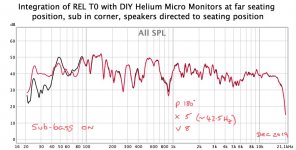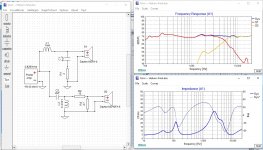Hi
Just carrying on with the audio tinkering.
I have a new REL T Zero to provide some low end support for my DIY Helium Micro Monitors. I set the system up with REW and can definitely hear the improvement in sound reproduction (bass) but wanted to tinker with a simple DIY passive high pass filter between the preamp and integrated amp (or integrated amp and speaker), that I recently built. The REL currently takes a parallel signal from the speaker terminals in the integrated amp and it has its own crossover controls (perhaps this can be changed to the preamp outs, before any filter).
My intent would be to see if the Dayton ND91-4 would benefit from removal of some of the work at around <50Hz or so. I have seen single capacitors used in this type of application with claims of improved sound. Is it worth trying?
The data for my REL integration testing is attached with some brief explanation included. These are in room measurements with mic at listening position.
Just carrying on with the audio tinkering.
I have a new REL T Zero to provide some low end support for my DIY Helium Micro Monitors. I set the system up with REW and can definitely hear the improvement in sound reproduction (bass) but wanted to tinker with a simple DIY passive high pass filter between the preamp and integrated amp (or integrated amp and speaker), that I recently built. The REL currently takes a parallel signal from the speaker terminals in the integrated amp and it has its own crossover controls (perhaps this can be changed to the preamp outs, before any filter).
My intent would be to see if the Dayton ND91-4 would benefit from removal of some of the work at around <50Hz or so. I have seen single capacitors used in this type of application with claims of improved sound. Is it worth trying?
The data for my REL integration testing is attached with some brief explanation included. These are in room measurements with mic at listening position.
Attachments
Last edited:
....The REL takes a parallel signal from the speaker terminals in the integrated amp and it has its own crossover controls....
So if you cut bass going into the amp, and the woofer takes signal coming out of the amp, how does the woofer get any bass?
Putting a 270uFd cap in line with the mini-speakers will change their bass-stress but can cause midbass resonance.
So if you cut bass going into the amp, and the woofer takes signal coming out of the amp, how does the woofer get any bass?
Putting a 270uFd cap in line with the mini-speakers will change their bass-stress but can cause midbass resonance.
Woops, error. Original post changed.
The capacitor (or any sort of 6dB low-pass filter) won't do much, unfortunately.
I've almost always had to use either an active filter or tinker with the crossover to achieve a null and the network usually requires a humongous capacitor as the bump is very low.
I'm assuming you already plugged the port?
I've almost always had to use either an active filter or tinker with the crossover to achieve a null and the network usually requires a humongous capacitor as the bump is very low.
I'm assuming you already plugged the port?
The capacitor (or any sort of 6dB low-pass filter) won't do much, unfortunately.
I've almost always had to use either an active filter or tinker with the crossover to achieve a null and the network usually requires a humongous capacitor as the bump is very low.
I'm assuming you already plugged the port?
No, I could try that simple experiment - thanks. Not sure how much the port contributes to the bass.
So if you cut bass going into the amp, and the woofer takes signal coming out of the amp, how does the woofer get any bass?
Putting a 270uFd cap in line with the mini-speakers will change their bass-stress but can cause midbass resonance.
Sounds like trouble!
Have you considered just altering the input coupling capacitors?
Not wanting to go back into either construction for mods 😩. Thought it may be doable as a separate component. Saw one post on the web that was just a box containing a capacitor.
So you know Zin (resistance) and could string a second much smaller external input coupling capacitor before it.. where does that leave you?
Was just blindly assuming this discussion was valid ?
Is a high-pass filter using a capacitor between the amp and the speaker worth it? - AVS Forum | Home Theater Discussions And Reviews
100v 250uf electrolytic caps seem to be readily available.
This value came from a lookup table for 80hz crossover and 8ohm speakers (Car Audio - Speaker Crossover Chart and Capacitance vs. Frequency Calculator(High-pass)). My speaker’s impedence was determined by the designer and it is approx 8ohms at 80hz see attached.
This value came from a lookup table for 80hz crossover and 8ohm speakers (Car Audio - Speaker Crossover Chart and Capacitance vs. Frequency Calculator(High-pass)). My speaker’s impedence was determined by the designer and it is approx 8ohms at 80hz see attached.
Attachments
Why not insert that capacitor into your sim and see how the impedance peak deals with it.
Don't use single polarised capacitors. They will be dealing only with AC.100v 250uf electrolytic caps seem to be readily available.
- Status
- This old topic is closed. If you want to reopen this topic, contact a moderator using the "Report Post" button.
- Home
- Amplifiers
- Chip Amps
- Passive high pass filter for small 2.1 system

